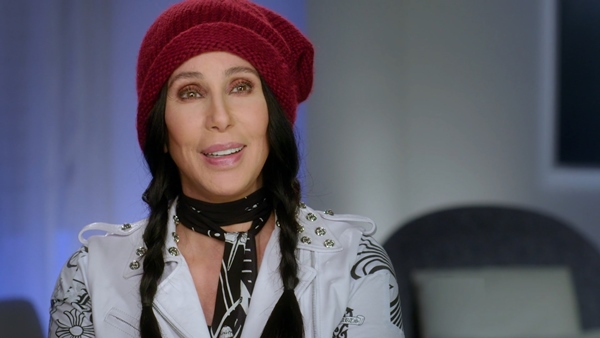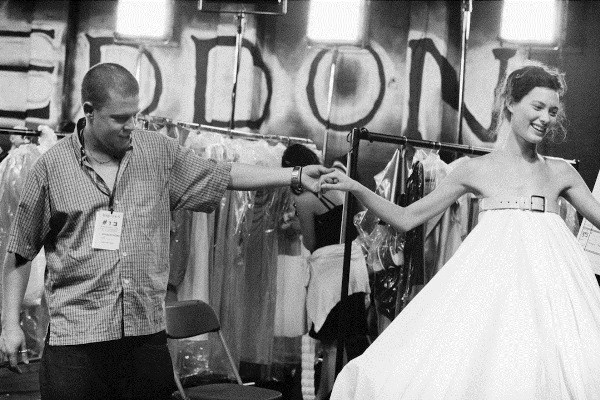“Fashion Victims,” that’s one salacious and glib headline that could top this review, and in this case, there would be some truth to the lurid lead.
Two documentaries look into two lives dominated by fashion. Two men rise above difficult beginnings to reach the top of their fields and adorn society’s swans, while achieving fame beyond their giddiest dreams. They demand a lot from themselves and others, and they feel the bite of a fickle, vicious industry, always hungry for new blood. Both stories end tragically. The difference is that makeup artist Kevyn Aucoin reached his apex firmly within the world of fashion, but designer Alexander McQueen challenged fashion and transcended it.
Tiffany Bartok’s Larger than Life: The Kevyn Aucoin Story struggles to balance its infatuation with fashion’s star-studded past against a deeper study of a gentle, troubled man. Bartok initially paints an affecting portrait of the young Aucoin that may feel familiar to many American gay men. A tall, lanky boy from Lafayette, Louisiana, Aucoin yearned for glamor and burned with love for Barbra Streisand and a compulsion to make over his sisters, his friends, and himself into colorful beauties. School bullies tormented Aucoin, and while still in his teen, he set out for New York. The ambitious young man stayed in touch with his adoptive family, and their humorous, pained memories of him provide many of the film’s touching moments.
Aucoin’s talent for drawing out the drama in the human face with a brush and liner quickly propelled him to the center of fashion circles in the ostentatious 1980s, and his career thrived through the 1990s’ more elegant era of the supermodel. He even got a chance to touch up his idol, Barbra Streisand. The film establishes that Aucoin elevated makeup styling to a higher level than before and turned it into a discipline in its own right. Bartok has some good gets: Isabella Rossellini and Paulina Porizkova rhapsodize over Aucoin’s talent, and Cher and Tori Amos share their affection for the charming man with the enormous hands. Images flash by of Aucoin with Janet and Gwyneth and Linda and Naomi, making sure we know that he was the go-to guy for the beautiful people. The garrulous Isaac Mizrahi’s is a go-to guy himself these days as a talking head for fashion documentaries. His gushing recollection of how some unorthodox Aucoin eyelashes defied the fashion police is an example of how trivial fashion can look to outsiders.
Behind the glittering surfaces of Aucoin’s career lurked fear and doubt. Lovers, friends, and relatives recall Aucoin’s health problems, an upsetting family revelation, and his struggle to stay current in a milieu that ruthlessly discards yesterday’s darlings. The film implies that he might have relied too much on his cachet with celebrities; Amos flatly declares, “We let him down.” Home movies reveal Aucoin’s more introspective, tender moments, but they were numbered: the makeup artist was addicted to prescription pills. He died in 2002, just before the social media age took flight; one wonders how Aucoin would have weathered the disruptions of social media on today’s hard-to-pin-down fashion world.
“Fashion is this big bubble, and sometimes I want to pop it,” so said designer Alexander McQueen, who came out of the lower-middle-class nowhere to enthrall and enervate a blasé fashion establishment, and his creations are still shocking eight years after his suicide. It may seem puffed-up to use the word oeuvre in connection with fashion, but the Metropolitan Museum’s Costume Institute 2010 exhibit on McQueen showcased a glittering body of work in a way unequalled before or since. More than a million people saw the show, a masterpiece of lighting and sound design framing skull headdresses crowned with horns, dresses sculpted out of razor clams, and shoes seemingly worn by invading Martian foot soldiers. McQueen’s haunting, feral creations draw on some obsidian inner essence apart from ordinary life.
Ian Bonhôte and Peter Ettedgui’s McQueen pays tribute to its subject with suitable artistry. The McQueen signature skull appears as a melting, shimmering, floating motif to mark different points in the designer’s story, and composer Michael Nyman wrote the regal score. Tart interviews—sorry, America, the British do interviews better than you do—sharply pinpoint McQueen as a talent from day one. They trace McQueen’s start as a tailor in Savile Row and identify one of the roots of his success to his impeccable craftsmanship. Art school classmates reminisce more revealingly than in most biodocs—McQueen had a habit of enlisting those around him in tight circles of accomplices and devotees. These shifting crews of collaborators supported McQueen as he progressed from his anarchic first few Vivienne Westwood–esque shows to head creative posts at Givenchy and Gucci, up there with rival John Galliano.
Drugs and power-tripping became part of the McQueen method, and fashion luminaries like Kate Moss and Tom Ford have their say about the trip. So, touchingly, does McQueen’s bereaved family. Sad secrets from the past are shared that may hold the key to McQueen’s inner discomfort, a force that gained strength as pressure mounted on him to produce mind-blowing collections. Just as fashion does, McQueen flirts with controversy while shying away from unflattering views. It soft-pedals the suicide of McQueen mentor Isabella Blow and lets insinuations of McQueen’s abusive behavior toward friends and associates go unexplored.
But it’s the clothes and the spectacle around them that won’t let you go. McQueen put together shows incorporating shattering glass, wind tunnels, and staggering models as rape victims. The sight of two undulating robots orgasmically squirting a revolving model’s dress with black and green paint is startling and wickedly funny. McQueen incorporated digital printing and other innovations into his work, as he was looking at the future. Yet the road is long, and not everyone can stay on it. By the time McQueen killed himself at age 40, he had created visions far beyond the limits of fashion and its sycophants. McQueen is an absorbing ode to his dark brilliance.


















Leave A Comment